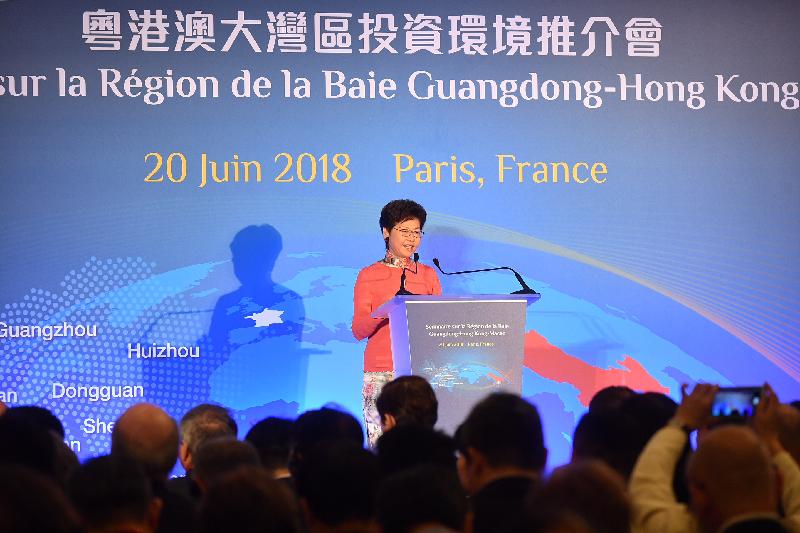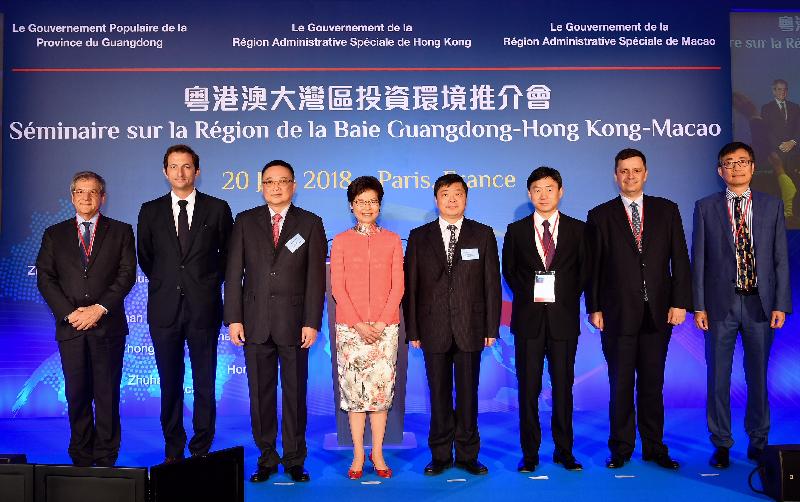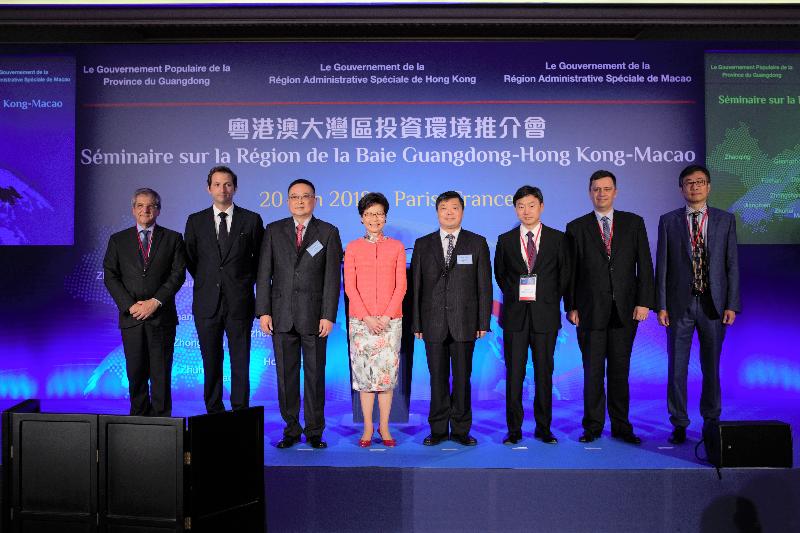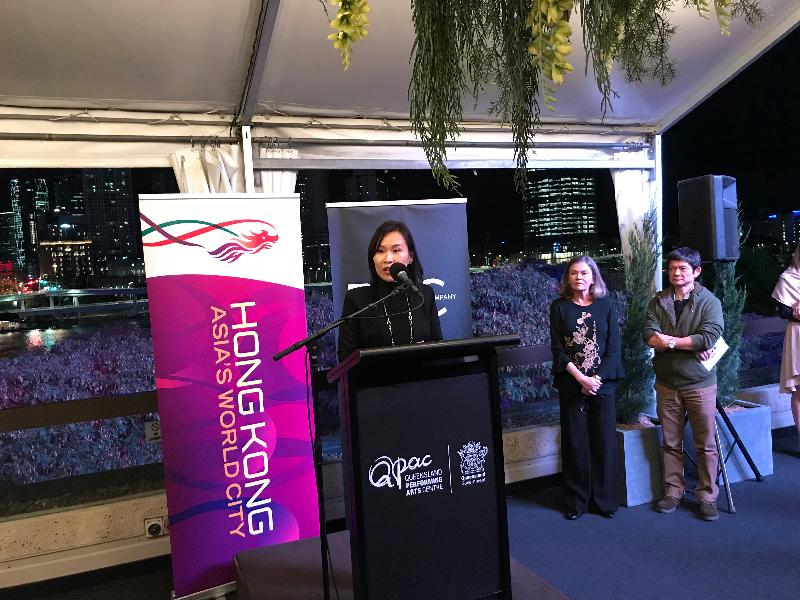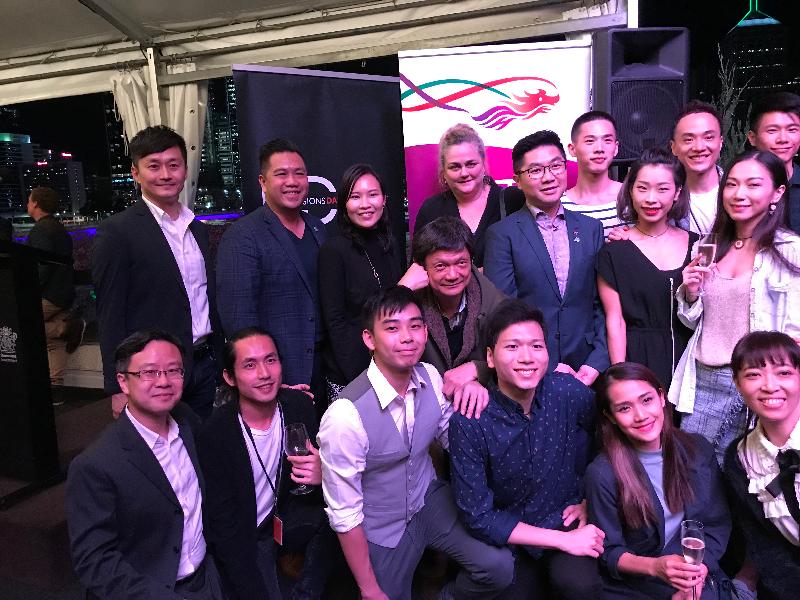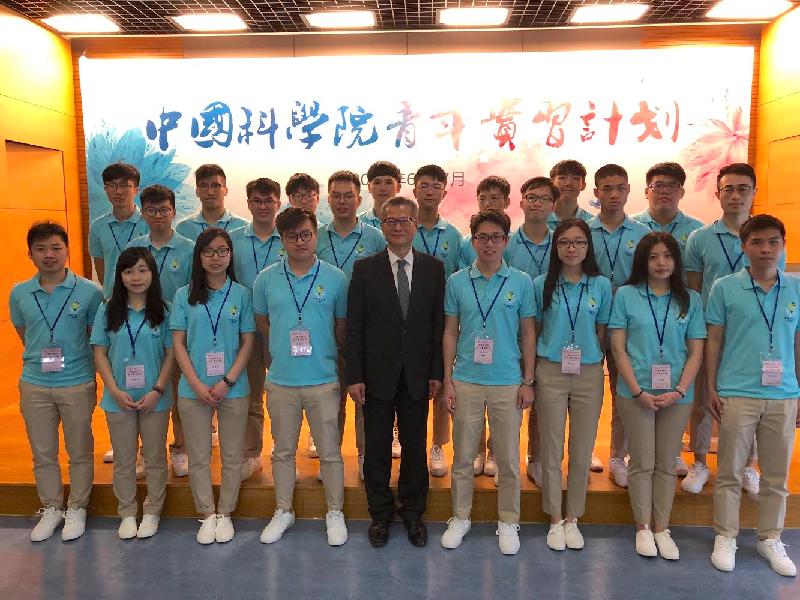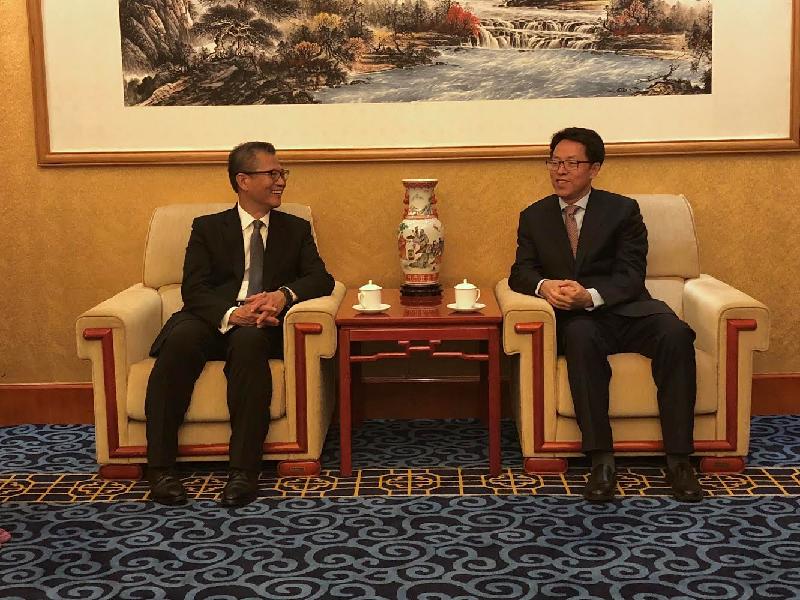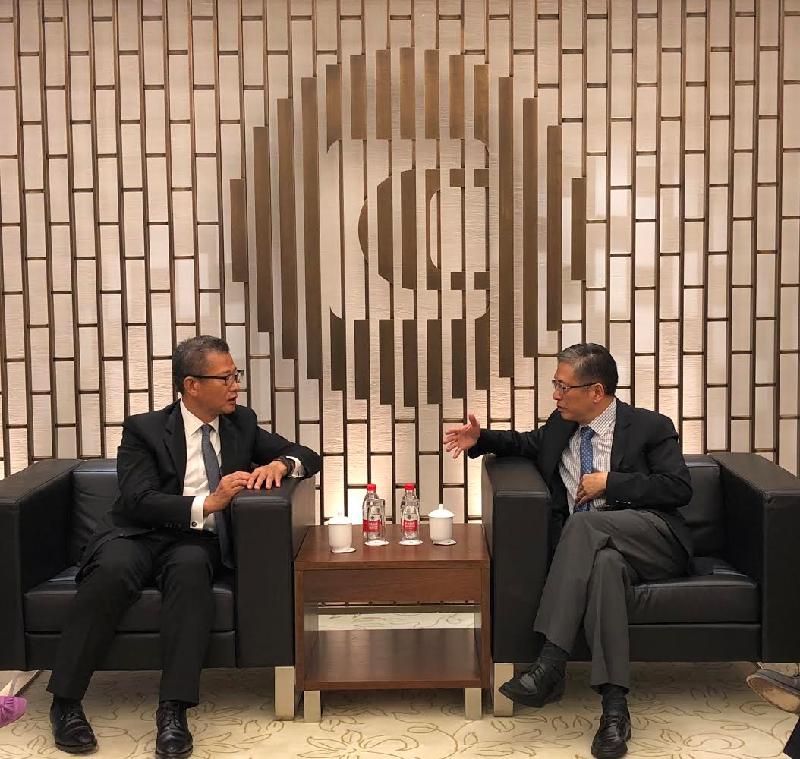Speech by CE at the joint promotion seminar on Guangdong-Hong Kong-Macao Bay Area development in Paris (English only) (with photos/video)
Following is the speech by the Chief Executive, Mrs Carrie Lam, at the joint promotion seminar on Guangdong-Hong Kong-Macao Bay Area development in Paris, France today (June 20, Paris time):
Mr Ouyang Weimin, Vice Governor of Guangdong Province, Mr Jackson Chang, President of Macao Trade and Investment Promotion Institute, and Mr Wu Xiaojun, Chargé d'Affaires of the Chinese Embassy in France, ladies and gentlemen,
It really gives me great pleasure to be able to welcome you to this conference, organised by the Hong Kong Special Administrative Region (SAR) Government represented by Invest Hong Kong, and also our counterparts in Guangdong and Macao. There are a number of firsts for this particular occasion. One, this is my first trip to continental Europe in my new capacity as the Chief Executive of the HKSAR. Secondly, it's the first joint effort of Guangdong, Hong Kong and Macao in promoting this very exciting initiative of the Guangdong-Hong Kong-Macao Bay Area to our overseas friends here in France. And speaking more personally, I'm the first lady Chief Executive of Hong Kong. So to me, this is a very historic moment.
Since I'm the first to speak, I will start by giving you a bit of background and context about this Bay Area. The concept of the Bay Area emerged from very important statements made by the leaders in the last couple of years. In the 13th Five-Year Plan for the Economic and Social Development of the People's Republic of China, it was made very clear that the Central Government will support the joint efforts by Guangdong, Hong Kong and Macao to build a quality living area in the Greater Pearl River Delta region and accelerate the development of several areas within this Bay Area, which have been given special status in terms of being a free port – they are Qianhai, Nansha and Hengqin. They will become the platforms for co-operation between Guangdong, Hong Kong and Macao. The Central Government will encourage Hong Kong and Macao to play an important part in the Pan-Pearl River Delta Region co-operation and the development of this Guangdong-Hong Kong-Macao Bay Area.
Then further on, when Premier Li Keqiang delivered his annual work report in March last year, he said that "We will promote closer co-operation between the Mainland and Hong Kong and Macao. We will draw up a plan for the development of a city cluster in the Guangdong-Hong Kong-Macao Bay Area, give full play to the distinctive strengths of Hong Kong and Macao, and elevate their positions and roles in China’s economic development and opening up".
Just to give you a feel of the major city clusters in the world, we generally refer to, apart from of course the Guangdong-Hong Kong-Macao Bay Area, the San Francisco Bay Area in America, the New York Metropolitan Area, also in the United States, and the Tokyo Bay Area. In so far as in China, there are also city cluster developments – because now the world is highly competitive, we need to look for co-operation and synergy among cities in order to raise the competitiveness of the economic region. So, apart from the Guangdong-Hong Kong-Macao Bay Area, which I would say is a latecomer – we are emerging in the last couple of years – we have the Yangtze River Delta which comprises the very affluent city of Shanghai and the adjacent provinces, and the Jingjinji Metropolitan Region which comprises Beijing, Tianjin and Hebei Province.
Coming back to the Bay Area, it consists of nine most affluent cities in the Guangdong Province and the two SARs of Hong Kong and Macao. Now some of the basic facts about this particular Bay Area – the land mass is 56 000 kilometres, many times bigger than Hong Kong which has only 1 100 square kilometres. In terms of population, it is quite large: sixty-eight million is about the size of the United Kingdom. In terms of GDP, it is US$1.5 trillion, which is roughly the size of Australia or South Korea. Of course Macao has the highest GDP per capita in this region because of its smaller population and it's doing very well in the gaming business. We are not bad – we are number two with per capita GDP of US$46,200. But since in general, China is still a developing country, and that is the beauty of this Bay Area, it still has a lot of energy to grow. The GDP per capita of the entire region is about US$21,760.
This area is characterised by very good connectivity with the rest of the world, as illustrated by the number of airports and the number of ports in this region. In terms of Hong Kong, we are the world's number one in terms of air cargo, making the mark of 5 million tonnes of air cargo last year, which was very remarkable. In terms of the port, we used to be number one, but we have come down a bit. We are now the world's number five. But within this Bay Area we have the Shenzhen port, which is up and coming. We have the Guangzhou Nansha port, which is also growing. So the port business and the airport traffic within this region are really very active and booming.
How do we compare with the other Bay Areas that I have just shown you on the map? In terms of population, we are the largest, which means that we have huge potential because people drive productivity and growth. In terms of GDP, we are growing. I am very confident that we will catch up the other Bay Areas pretty soon, because the difference is actually quite narrow now. We have very strong air traffic, as I have just described, and in terms of the port and air passenger travel, this is really a very important area in the world.
I'm going to spend a few minutes to share with you what I see as the favourable conditions for developing the Bay Area. These are the favourable conditions for French businesses and overseas businesses to work with us in this Bay Area.
Favourable condition number one is the national significance and the mandate given to us by the leaders. So let me take you through a few of these statements. In his 19th CPC National Congress report, General Secretary and President Xi Jinping has this to say about the Bay Area and the development of Hong Kong and Macao. President Xi said that the Central Government will continue to support Hong Kong and Macao in integrating their own development into the overall development of the country. And priority will be given to the development of the Guangdong-Hong Kong-Macao Bay Area and the regional co-operation in the Pan-Pearl River Delta.
And then in Premier Li Keqiang's report earlier this year – you remember in the history part I told you Premier Li Keqiang in his March 2017 report, he talked about that we will draw up a plan. So, a year later, in his March 2018 report, the Premier has this to say: "We will unveil and implement the development plan for the Guangdong-Hong Kong-Macao Bay Area, and promote in all areas mutually beneficial co-operation between the Mainland, Hong Kong and Macao", which implies the development plan is more or less ready and will shortly be announced.
Another very important milestone in the Bay Area took place on the 1st of July last year. That is the day when I took office and when President Xi was in Hong Kong to supervise the inauguration ceremony. We signed, in the presence of President Xi, a very important framework agreement on deepening cooperation in the Guangdong-Hong Kong-Macao Bay Area. As you can see, there were four parties signing this framework agreement. They represented the three governments – Guangdong, Hong Kong, Macao – and the Chairman of the National Development and Reform Commission, because it is about integrating not only within the Bay Area but into the national development. That's why the National Development and Reform Commission plays a very key role in the Bay Area development. A development plan shortly to be announced will have the status of endorsement by the State Council of the People's Republic of China and, although it has not been announced yet, I can share with you a few highlights in the development plan.
One is the objective. What is the purpose of doing a Bay Area? It's to strive to develop this Bay Area into a more dynamic economic region, a quality living circle which is an ideal place for living, working, travelling, and a showcase for in-depth co-operation between the Mainland, Hong Kong and Macao, and join hands in building a first-class Bay Area. So the aspirations for this Bay Area are very high. We are aiming at the international level to do our joint co-operation and the principles of co-operation are complementarity. We don't want to compete directly amongst ourselves. Well, as a Bay Area we may wish to compete with other Bay Areas, both in the Mainland of China and all over the world. But within the Bay Area, we will try to work with each other to achieve what we call a win-win situation, and the key co-operation areas in the Bay Area will include infrastructure connectivity in order to achieve that living circle which is very convenient for people; market integration, whether it is in trade, in commerce, in financial services and investment; and also in technology and innovation.
The second favourable condition is of course "One Country, Two Systems". We are not identical. This is a Bay Area which is unusual and unique because of "One Country, Two Systems". So, we have our own system and Macao has its own system under "One Country, Two Systems". As far as Hong Kong is concerned, we have the rule of law and the independence of judiciary. We are very strong in terms of being an international trade and financial centre and we are the world's freest and most competitive economy. We provide quality professional services to other enterprises and we have very good universities that are involved in research and development in Hong Kong. And being an international financial centre and a free economy, there are absolutely no barriers in the flow of capital and information in Hong Kong.
There has been some concern raised recently in some quarters: if you are talking about an integrated Bay Area, does that mean that this "One Country, Two Systems" principle which is so very important will be eroded? The answer is no. This Bay Area prides itself on "One Country, Two Systems", and the most authoritative reply to that concern came from Premier Li Keqiang. Having finished the "two sessions" this year in Beijing, at a press conference for local and overseas journalists, Premier Li Keqiang, in response to an enquiry along the lines that I have just mentioned, he has this to say. He said that the Central Government encourages Hong Kong and Macao to integrate their own development into the overall national development. In this process, we will continue to observe the principle of "One Country, Two Systems", under which the people of Hong Kong administer Hong Kong, the people of Macao administer Macao, and both regions enjoy a high degree of autonomy. As there can be mutually beneficial co-operation and common development between different countries, there is even more reason for the three places which belong to one and the same country to do so. Under the guidance of "One Country, Two Systems" principle, we are confident that these three areas will draw upon each other's strengths and work together in building a new and strong region of vibrant growth.
The third favourable condition is enhanced connectivity, because one of the objectives of this Bay Area is the free flow of people and goods. And we want to develop a living circle which is very convenient for the 68 million people in the Bay Area. So I'm very excited to share with you that we now have three major cross-boundary infrastructure projects that will be commissioned pretty soon, and a major French construction company actually is involved in some of these major infrastructure projects. Number one is the Hong Kong-Zhuhai-Macao Bridge, which will connect Hong Kong to the other two parts in the Bay Area – Macao and Zhuhai, which is one of the nine cities on the western part of Guangdong Province. We are going to open an Express Rail Link connecting Hong Kong in 48 minutes to Guangzhou and even shorter distance to Shenzhen, and from there to the rest of China with an extensive high-speed rail of close to 30 000 kilometres. And we are going to open an additional, which is the seventh, land-based control point between Hong Kong and the eastern part of Shenzhen. These particular control points are the busiest in the world, handling over 600 000 passenger trips every day, so you can imagine this frequency and flow of people between the two places.
The fourth favourable condition is there is already very strong commitment from the three places – Hong Kong, Guangdong, Macao – to facilitate the flow of people, goods, capital and information in the Bay Area. Last November, the Guangdong Governor, Mr Ma Xingrui and I had an annual meeting between Hong Kong and Guangdong and we already agreed that while waiting for the development plan to be announced, we could start working on some of the key areas within the Bay Area, building on our previous closer relationship on the CEPA, Closer Economic Partnership Arrangement, and this liberalisation of trade in services in Guangdong that has been put in place over the past decade.
Of course, some of these facilitating measures could only come from the Central Government. So, in order to have more facilitating measures for people from Hong Kong and Macao to live and work and study in the Bay Area, we do need some Central Government supporting measures, and we have those measures made available to us in phases. In August and December last year when I was in Beijing, on both occasions the Central Government has announced some of the facilitating measures to make it easier for Hong Kong people to study, to work or even to buy flats in the Bay Area, and we are very grateful for that.
And finally, there is this aspiration to build an international innovation and technology hub in the Bay Area on par with or even exceeding the Silicon Valley in the San Francisco Bay Area. And why do we have this aspiration? It's because of the complementarity of the three places. Hong Kong has very strong R&D capacity because four of our universities are within the top 100 universities in the world and they are very strong in research. And Shenzhen has huge advanced manufacturing capacity and I would say that this is not only in Shenzhen. In other cities in the Bay Area, they are now building up very advanced manufacturing, electronic production capacity. So this formula of office in Hong Kong, R&D in Hong Kong, advanced manufacturing in the Bay Area cities and then if you need to scale up your business you come back to Hong Kong to use the financial services to seek listing and to raise capital or to issue bonds. It is a very attractive proposition which may not be readily available in other Bay Areas that I have mentioned.
And we have a wonderful project which is a science park, a second science park based in Hong Kong, developed jointly with Shenzhen. We expect this 87 hectares of science park to be available in two to three years' time.
When I said that we have this aspiration, it's not empty talk. We already have some of the measures put in place to attract more R&D institutions to Hong Kong, so my trip to Paris will involve some visits to the tech companies like Station F and also I went to visit Ecole Polytechnique yesterday in order to learn more about their research capacity.
I would conclude by saying that there are exciting times ahead of us in this Guangdong-Hong Kong-Macao Bay Area and we welcome all of you – French companies, Chinese companies and Hong Kong companies – to join hands with us in growing this very important Bay Area, not only for Hong Kong, Macao, Guangdong, not only for China, but for the world.
Thank you very much.
